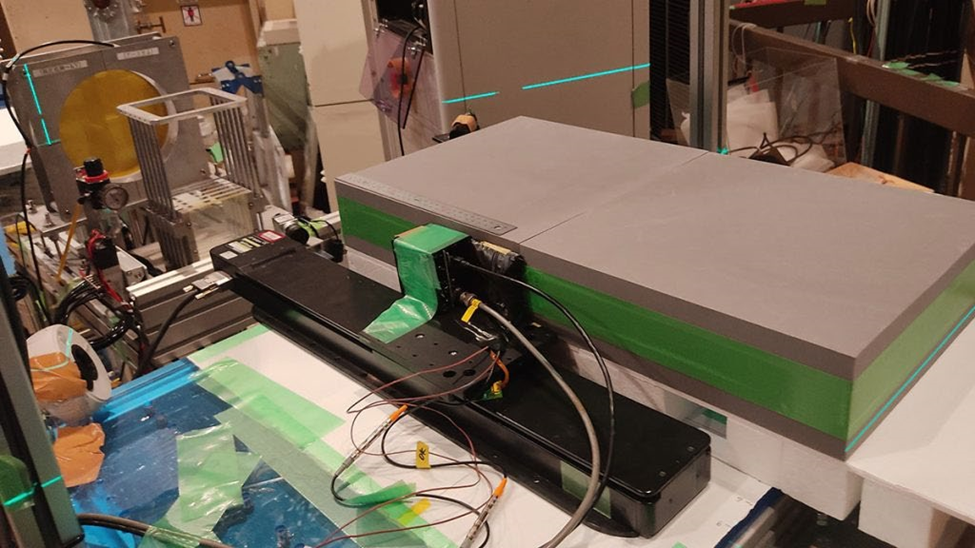Advancing Muon Therapy with Red Pitaya
- Posted by
 Red Pitaya Team
, June 17, 2024
Red Pitaya Team
, June 17, 2024

Enhancing Muon Therapy Research with Red Pitaya's DAQ System
In the field of radiation therapy, precision in measuring dose distribution is critical for effective treatment. The Sakura Particles team, composed of Japanese high school students, has developed innovative methods to measure dose distribution during proton therapy, using a modified Cosmic Watch detector. They are now advancing their research to use muon beams at CERN, leveraging Red Pitaya's DAQ (Data Acquisition) system to facilitate their experiments.
The Challenge of Measuring Dose Distribution
Proton therapy delivers precise doses of radiation, targeting tumors while sparing the surrounding healthy tissue due to the Bragg peak effect. But accurate measurement of the dose distribution is vital for optimizing treatment plans. The Sakura Particles team has thus designed an online monitoring detector, initially tested with an 80 MeV proton beam, to measure the dose distribution in real-time. The results aligned well with simulation data, indicating the system's accuracy.



Figure 1. The experimental setup of the detector performance test at Cyclotron Radioisotope Center. The detector mounted on a linear manipulator scans the radiation from the phantom box.
Using Muons for Enhanced Measurement
Building on their proton therapy research, the team is exploring high-energy muon beams. Muons can penetrate deep into the body and produce decay positrons and gamma rays, providing additional data points for dose distribution. The experiment involves irradiating a water tank (acting as a body phantom) with a muon beam and using a detector mounted on a linear actuator to scan the tank, reconstructing the dose distribution, and focusing on identifying the Bragg peak.


Figure 2. The schematic setup of this experiment. Muon beams irradiate the phantom (water tank) and measure the radiation on the side of this phantom.
The Role of Red Pitaya’s DAQ System
Red Pitaya's DAQ system is central to the success of this experiment. It records every energy deposit by each particle, allowing precise data collection even at high rates (up to 10^5/s). The accuracy and reliability of Red Pitaya's system are crucial for capturing detailed measurements during the scanning process.
Red Pitaya provides a highly versatile and user-friendly platform that integrates seamlessly with various sensors and detectors. Its powerful FPGA (Field Programmable Gate Array) and fast ADCs (Analog-to-Digital Converters) enable the high-speed data acquisition needed for such detailed experiments. The open-source nature of Red Pitaya also allows the team to customize the software and hardware to meet their specific experimental requirements, ensuring that the data collected is both comprehensive and precise.
Moreover, the Red Pitaya device's compact design and portability make it an excellent tool for field experiments. The ability to handle high data throughput with minimal latency ensures that even the most transient phenomena are captured accurately. For the Sakura Particles team, this means every particle interaction is recorded in real-time, allowing for precise reconstruction of the dose distribution.
Experimental Plan and Simulation
The experiment will be conducted with a 0.2 GeV muon beam, with a beam profile of 1-3 cm in diameter and a flux of approximately 10^4/s. The scanning sequence involves two round-trip scans of 10 minutes each, performed at a distance of 100 cm from the beam axis. Background scans will be conducted before and after the experiment to account for environmental radiation. Simulations using PHITS have shown that the expected dose distribution can be accurately measured, providing critical insights into the energy deposit at different depths.


Figure 3. The simulated energy deposit measured by the detector when the distance between the beam axis and the side of the phantom is 3, 6, and 9 cm.
Outreach and Future Impact
The Sakura Particles team aims to share their findings and experiences widely. They plan to use social media platforms like Twitter, Instagram, and YouTube to document their journey and engage with other students interested in particle physics. Additionally, they will present their results at conferences and publish papers to contribute to the broader scientific community.
By demonstrating the feasibility and importance of accelerator-based experiments, the team hopes to inspire more students to pursue research in particle physics and radiation therapy. Their work, supported by Red Pitaya's cutting-edge technology, represents a significant step forward in the application of muon beams for medical treatment.
Conclusion
The innovative work of the Sakura Particles team, supported by Red Pitaya's DAQ system, highlights the potential of muon therapy as a future cancer treatment. Accurate dose distribution measurement is a cornerstone of effective radiation therapy, and this research could pave the way for more precise and effective treatments. As these young researchers continue to push the boundaries of what’s possible, they are not only advancing science but also inspiring the next generation of physicists and engineers.
Stay tuned for more updates from the Sakura Particles team as they continue their groundbreaking experiment at CERN.


.jpg?width=767&name=blog%20featured%20image%20(100).jpg)
.jpg?width=767&name=blog%20featured%20image%20(85).jpg)

